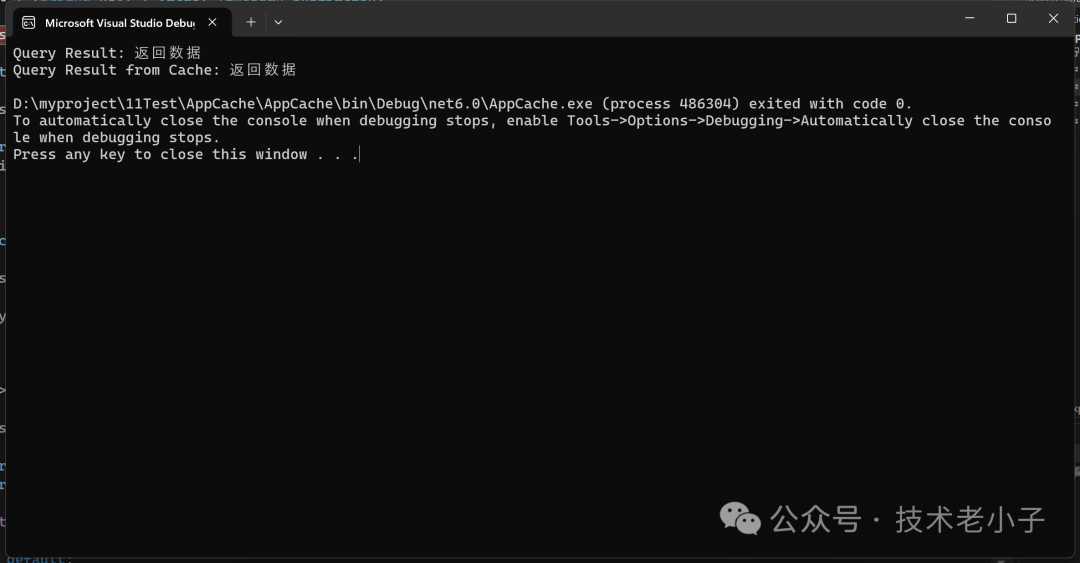在现代应用程序中,缓存是一种有效的优化手段,能够显著提高系统的性能,减少延迟。缓存可以用于数据库查询结果的存储、API 响应的缓存、复杂计算结果的保存等多个场景。本文将介绍如何开发一个通用的 CacheService 类,并展示其在不同场景中的应用。
引言
缓存是一种存储机制,用于临时性地保存数据,以减少数据获取的时间和频次。在高性能应用程序中,合理使用缓存,可以显著提高系统的响应速度,减轻后台服务的负担。接下来我们讲解如何开发一个通用的 CacheService 并展示其在具体场景中的应用。
开发通用的 CacheService
ICacheService 接口
首先,定义一个 ICacheService 接口,定义基本的缓存操作:
using System;
using System.Threading.Tasks;
public interface ICacheService
{
void Set<T>(string key, T value, TimeSpan expiration);
T Get<T>(string key);
Task SetAsync<T>(string key, T value, TimeSpan expiration);
Task<T> GetAsync<T>(string key);
void Remove(string key);
Task RemoveAsync(string key);
}CacheService 实现
接下来,开发 CacheService 类,它实现了 ICacheService 接口。该类同时支持内存缓存和分布式缓存(例如 Redis),基于启动时的配置选择缓存方式:
using System;
using System.Threading.Tasks;
using Microsoft.Extensions.Caching.Memory;
using Microsoft.Extensions.Caching.Distributed;
using Microsoft.Extensions.Logging;
public class CacheService : ICacheService
{
private readonly IMemoryCache _memoryCache;
private readonly IDistributedCache _distributedCache;
private readonly ILogger<CacheService> _logger;
private readonly bool _useDistributedCache;
public CacheService(IMemoryCache memoryCache, IDistributedCache distributedCache, ILogger<CacheService> logger, bool useDistributedCache = false)
{
_memoryCache = memoryCache;
_distributedCache = distributedCache;
_logger = logger;
_useDistributedCache = useDistributedCache;
}
public void Set<T>(string key, T value, TimeSpan expiration)
{
if (_useDistributedCache)
{
var options = new DistributedCacheEntryOptions
{
AbsoluteExpirationRelativeToNow = expiration
};
var serializedValue = System.Text.Json.JsonSerializer.Serialize(value);
_distributedCache.SetString(key, serializedValue, options);
}
else
{
var cacheEntryOptions = new MemoryCacheEntryOptions
{
AbsoluteExpirationRelativeToNow = expiration
};
_memoryCache.Set(key, value, cacheEntryOptions);
}
}
public T Get<T>(string key)
{
if (_useDistributedCache)
{
var serializedValue = _distributedCache.GetString(key);
if (serializedValue != null)
{
return System.Text.Json.JsonSerializer.Deserialize<T>(serializedValue);
}
return default;
}
_memoryCache.TryGetValue(key, out T value);
return value;
}
public async Task SetAsync<T>(string key, T value, TimeSpan expiration)
{
if (_useDistributedCache)
{
var options = new DistributedCacheEntryOptions
{
AbsoluteExpirationRelativeToNow = expiration
};
var serializedValue = System.Text.Json.JsonSerializer.Serialize(value);
await _distributedCache.SetStringAsync(key, serializedValue, options);
}
else
{
var cacheEntryOptions = new MemoryCacheEntryOptions
{
AbsoluteExpirationRelativeToNow = expiration
};
_memoryCache.Set(key, value, cacheEntryOptions);
}
}
public async Task<T> GetAsync<T>(string key)
{
if (_useDistributedCache)
{
var serializedValue = await _distributedCache.GetStringAsync(key);
if (serializedValue != null)
{
return System.Text.Json.JsonSerializer.Deserialize<T>(serializedValue);
}
return default;
}
_memoryCache.TryGetValue(key, out T value);
return await Task.FromResult(value);
}
public void Remove(string key)
{
if (_useDistributedCache)
{
_distributedCache.Remove(key);
}
else
{
_memoryCache.Remove(key);
}
}
public async Task RemoveAsync(string key)
{
if (_useDistributedCache)
{
await _distributedCache.RemoveAsync(key);
}
else
{
_memoryCache.Remove(key);
}
}
}配置依赖注入
在项目的 Program.cs 中配置依赖注入:
using System;
using Microsoft.Extensions.DependencyInjection;
using Microsoft.Extensions.Caching.Memory;
using Microsoft.Extensions.Caching.Distributed;
using Microsoft.Extensions.Logging;
public class Program
{
static void Main(string[] args)
{
var serviceProvider = new ServiceCollection()
.AddMemoryCache()
.AddStackExchangeRedisCache(options =>
{
options.Configuration = "localhost:6379";
})
.AddLogging()
.AddSingleton<CacheService>()
.BuildServiceProvider();
// 使用缓存服务的示例
var cacheService = serviceProvider.GetService<CacheService>();
cacheService.Set("key1", "value1",new TimeSpan(0, 10, 0));
var value = cacheService.Get<string>("key1");
}
}我们还可以启用分布试的缓冲(Redis);
static void Main(string[] args)
{
var serviceProvider = new ServiceCollection()
.AddMemoryCache()
.AddStackExchangeRedisCache(options =>
{
options.Configuration = "localhost:6379";
})
.AddLogging()
.AddSingleton<CacheService>(sp =>
{
var memoryCache = sp.GetRequiredService<IMemoryCache>();
var distributedCache = sp.GetRequiredService<IDistributedCache>();
var logger = sp.GetRequiredService<ILogger<CacheService>>();
return new CacheService(memoryCache, distributedCache, logger, useDistributedCache: true);
})
.BuildServiceProvider();
// 使用缓存服务的示例
var cacheService = serviceProvider.GetService<CacheService>();
cacheService.Set("key1", "value1",new TimeSpan(0, 10, 0));
var value = cacheService.Get<string>("key1");
} 图片
图片
缓存应用场景示例
数据库查询结果缓存
DatabaseService.cs
using System;
public class DatabaseService
{
private readonly ICacheService _cacheService;
public DatabaseService(ICacheService cacheService)
{
_cacheService = cacheService;
}
public string GetDataFromDatabase(string query)
{
string cacheKey = $"DatabaseQuery-{query}";
var cacheData = _cacheService.Get<string>(cacheKey);
if (cacheData != null)
{
return cacheData;
}
// 模拟数据库查询操作
string data = "返回数据";
_cacheService.Set(cacheKey, data, TimeSpan.FromMinutes(5));
return data;
}
}程序入口
internal class Program
{
static void Main(string[] args)
{
var serviceProvider = new ServiceCollection()
.AddMemoryCache()
.AddStackExchangeRedisCache(options =>
{
options.Configuration = "localhost:6379";
})
.AddLogging()
.AddSingleton<CacheService>()
.AddSingleton<ICacheService, CacheService>()
.AddSingleton<DatabaseService>()
.BuildServiceProvider();
var databaseService = serviceProvider.GetService<DatabaseService>();
string query = "SELECT * FROM Users";
Console.WriteLine("Query Result: " + databaseService.GetDataFromDatabase(query));
// 再次调用以展示缓存效果
Console.WriteLine("Query Result from Cache: " + databaseService.GetDataFromDatabase(query));
}
} 图片
图片
API 响应缓存
ApiService.cs
using System;
using System.Net.Http;
using System.Threading.Tasks;
public class ApiService
{
private readonly ICacheService _cacheService;
private readonly HttpClient _httpClient;
public ApiService(ICacheService cacheService, HttpClient httpClient)
{
_cacheService = cacheService;
_httpClient = httpClient;
}
public async Task<string> GetApiResponseAsync(string url)
{
string cacheKey = $"ApiUrl-{url}";
var cacheData = await _cacheService.GetAsync<string>(cacheKey);
if (cacheData != null)
{
return cacheData;
}
var response = await _httpClient.GetStringAsync(url);
await _cacheService.SetAsync(cacheKey, response, TimeSpan.FromMinutes(10));
return response;
}
}程序入口
using System.Net.Http;
using System.Threading.Tasks;
public class Program
{
public static async Task Main(string[] args)
{
var serviceProvider = new ServiceCollection()
.AddMemoryCache()
.AddStackExchangeRedisCache(options =>
{
options.Configuration = "localhost:6379";
})
.AddLogging()
.AddSingleton<HttpClient>()
.AddSingleton<CacheService>()
.AddSingleton<ICacheService, CacheService>()
.AddSingleton<ApiService>()
.BuildServiceProvider();
var apiService = serviceProvider.GetService<ApiService>();
string apiUrl = "https://jsonplaceholder.typicode.com/posts";
var result = await apiService.GetApiResponseAsync(apiUrl);
Console.WriteLine("API Response: " + result);
// 再次调用以展示缓存效果
var cachedResult = await apiService.GetApiResponseAsync(apiUrl);
Console.WriteLine("Cached API Response: " + cachedResult);
}
} 图片
图片
复杂计算结果缓存
CalculationService.cs
using System;
public class CalculationService
{
private readonly ICacheService _cacheService;
public CalculationService(ICacheService cacheService)
{
_cacheService = cacheService;
}
public int HeavyComputation(int input)
{
string cacheKey = $"HeavyComputation-{input}";
var cacheData = _cacheService.Get<int>(cacheKey);
if (cacheData != 0)
{
return cacheData;
}
// 模拟复杂计算
int result = input * input;
_cacheService.Set(cacheKey, result, TimeSpan.FromMinutes(10));
return result;
}
}程序入口
public class Program
{
public static void Main(string[] args)
{
var serviceProvider = new ServiceCollection()
.AddMemoryCache()
.AddStackExchangeRedisCache(options =>
{
options.Configuration = "localhost:6379";
})
.AddLogging()
.AddSingleton<CacheService>()
.AddSingleton<ICacheService, CacheService>()
.AddSingleton<CalculationService>()
.BuildServiceProvider();
var calculationService = serviceProvider.GetService<CalculationService>();
int input = 42;
Console.WriteLine("Computation Result: " + calculationService.HeavyComputation(input));
// 再次调用以展示缓存效果
Console.WriteLine("Cached Computation Result: " + calculationService.HeavyComputation(input));
}
}总结
本文介绍了如何开发一个通用的 CacheService,并展示了其在不同场景中的应用:数据库查询结果缓存、API 响应缓存、复杂计算结果缓存。这种通用的缓存服务设计,可以显著提高应用的性能和响应速度,减少对外部资源(如数据库、外部 API)的频繁访问,从而优化用户体验。
通过上述示例,开发者可以更轻松地在项目中集成和管理缓存,提高应用的整体性能和可靠性。希望本文对你有所帮助,能够在实际项目中充分利用缓存技术。


































